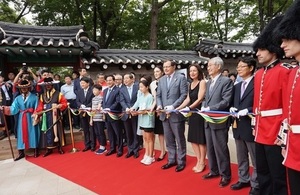Doldamgil road opens to public in Seoul
The opening of Doldamgil shows the British Embassy's commitment to historical Deoksugung Palace area.

Opening of Doldamgil
The British Embassy Seoul is delighted that the Doldamgil road was opened to the public on 30 August 2017. The Embassy has long understood the importance of the Deoksugung Palace area to the Korean people - which is why since 2010 it has worked closely with SMG to find a solution to the Doldamgil road issue. In 2015 British Ambassador, Charles Hay, signed a MoU committing to finding a solution which would benefit all those who visit the beautiful Deoksugung Palace.
As part of this commitment, the Embassy looked into the possibility of opening up part of the land owned by the Embassy to create a pathway all around the Palace. The British Embassy is a working office with regular visitors, with some staff and family members living on the compound. After detailed discussions with security experts - who came out to Korea from the UK – the Embassy concluded that for security reasons it could not agree to the plan of a pathway through our land. But the Embassy proactively agreed to return the 100m of road at the back of the Embassy that had been originally rented from Seoul Metropolitan Government - which is now the Doldamgil - and relocate the back gate in order to do this. Once this was agreed, the Embassy has done all it can to allow the work to be completed as quickly as possible. The Embassy is thrilled that the road is now open.
British Ambassador to South Korea, Charles Hay, said:
Whether residents of Seoul or visitors from other parts of Korea or abroad, I hope that as they walk along the road they will catch a glimpse the natural and cultural legacy of this area, and reflect on the unique contribution that it has played in the history of the great city of Seoul, and its relations with the rest of the world.
Additional Information
- The Embassy compound - aside from this road - was bought and has been legally owned by the British Government for over 130 years.
- In the 1960s (whether unilaterally or in consultation with Seoul City Authorities is not recorded) a decision was made not to renew the lease that had been taken out in the 1950s on the 100m stretch of land at the back of the Embassy. The Embassy continued to occupy it though, and over time it was assimilated into the Embassy compound. This fact was rediscovered and raised with the embassy in 2010. Since then, the British Embassy and Seoul Metropolitan Government (SMG) have been working together to find a solution.
- Under the 2015 MoU, the idea for a pathway through the Embassy’s land was suggested by SMG. The Embassy was committed to finding a solution that allowed for the development of a green cultural and historic zone at the heart of Seoul without compromising the security of our people and of our historic buildings. As with any such changes to the infrastructure/integrity of an Embassy compound, the proposal was thoroughly reviewed by security and other experts in the Foreign & Commonwealth Office (FCO) in London. Their decision was that the increased security risks associated with the project were not compatible with the FCO’s duty of care to Embassy staff, clients and visitors, and that there were no suitable mitigation measures that could be taken to reduce the risk to an acceptable level. The Embassy therefore reverted to the idea simply of returning the leased land.
- The Embassy is keen to give opportunities to the public to see the embassy and its grounds. It has participated in both the ‘Jeong-dong Culture night’ organised by Jung Gu government and the ‘Seoul Open Night’ organised by Seoul Metropolitan Government. This has allowed ordinary Korean citizens to come in and see the Embassy for themselves.